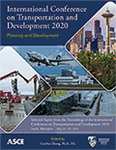International Conference on Transportation and Development 2020
Location and Development of Light Rail Stations under Demand Uncertainty: A Real Options Based Framework
Publication: International Conference on Transportation and Development 2020
ABSTRACT
Given the deepening awareness of the limited nature of fossil fuel reserves and the environmental consequences of consuming it, the increasing appetite for better public transportation infrastructure persists worldwide. A huge amount of investments and resources is being injected into the development of transportation infrastructures, including light rail, as the need for better and faster transportation is correlated with the economic development of a country. However, there is a serious lack of understanding regarding the underlying uncertainties, as well as their impact on the performance of these infrastructure projects. As a consequence, performance results that are lower than the forecasts are very common in rail transportation and financial or social benefit of light rail transits deviate hugely from what is expected. In many of these cases, either the overall cost of the project turns out to be much higher or the patronage proves to be far less than originally forecasted. This study aims at reducing such a gap in the literature by considering the uncertain nature of the demand. More specifically, this study proposes a real options-based framework for the feasibility analysis of the potential locations of light rail stations. First, it estimates the demand for each proposed station location considering the endogenous uncertainties involved in the forecasting of demand. Second, the feasibility of different station development scenarios is analyzed using the net present value (NPV) method. Third, a real options analysis is done on various development scenarios by considering the possible values of incorporating flexibility in the development. Fourth, based on the level and nature of the uncertainty in the station demand for each location, the economic benefits of incorporating flexibility for the station-development are quantified. Using a case study approach, the proposed model is applied for a station location on Dubai Metro Purple Line. The results suggest that recognizing the major uncertainties at an early stage and incorporating flexibility into the system design accordingly pays off under certain circumstances.
Get full access to this article
View all available purchase options and get full access to this chapter.
REFERENCES
Alozn, A. E. and A. Galadari (2017a). “Utility Function under Decision Theory: A Constructive Arbitration Application.” AIP Conference Proceedings 1867: 020001.
Alozn, A. E. and A. Galadari (2017b). “The Arbitrating Party Utility Function: An Expected Utility Approach.” Journal of Legal Affairs and Dispute Resolution in Engineering and Construction 9(3): 04517013.
Alrubaiai, H. and A. Galadari (2017) “The Future of Sustainable Public Transit in Abu Dhabi.” In E. Azar and M. Abdel Raouf (Eds), Sustainability in the Gulf: Challenges and Opportunities. Routledge, 123–144.
Caves, D. W., L. R. Christensen, et al. (1980). “Productivity in US railroads, 1951-1974.” The Bell Journal of Economics: 166–181.
Caves, D. W., L. R. Christensen, et al. (1981). “Economic performance in regulated and unregulated environments: a comparison of US and Canadian railroads.” The Quarterly Journal of Economics: 560-581.
Chester, M. and A. Horvath (2010). “Life-cycle assessment of high-speed rail: the case of California.” Environmental Research Letters 5(1): 014003.
De Neufville, R. and S. Scholtes (2011). Flexibility in engineering design, MIT Press.
De Neufville, R., S. Scholtes, et al. (2006). “Real options by spreadsheet: parking garage case example.” Journal of infrastructure systems 12(2): 107-111.
Norwegian Ministry of Finance (2014). Cost-Benefit Analysis. Retrieved April 06, 2014, from http://www.regjeringen.no/en/dep/fin/Documents-and-publications/official-norwegian-reports-/2012/nou-2012-16-2/7.html?id=713542.
Flyvbjerg, B., M. S. Holm, et al. (2002). “Underestimating costs in public works projects: Error or lie?” Journal of the American Planning Association 68(3): 279-295.
Freeman, K. D. (1985). “THE TOTAL FACTOR PRODUCTIVITY OF THE CANADIAN CLASS I RAILWAYS, 1956-1981.” Logistics and Transportation Review 21(3).
Galadari, A. (2008). Evaluation of Road Construction Alternatives: A Regretful Approach. PhD Dissertation, University of Colorado at Denver.
Galadari, A. (2016). “Regret Model for Resilience in Road Design.” Proceedings of the 11th International Conference on Urban Regeneration and Sustainability, 481–492.
Galadari, A. and H. al-Hammadi (2011). “Regret Model for Arbitration: Predicting the Outcome.” International Journal of Innovation, Management and Technology 2(6): 471–476.
Golob, T. F., M. J. Beckmann, et al. (1981). “A utility-theory travel demand model incorporating travel budgets.” Transportation Research Part B: Methodological 15(6): 375-389.
Graham, D. J., A. Couto, et al. (2003). “Economies of scale and density in urban rail transport: effects on productivity.” Transportation Research Part E: Logistics and Transportation Review 39(6): 443-458.
Oum, T. H. and C. Yu (1994). “Economic efficiency of railways and implications for public policy: A comparative study of the OECD countries’ railways.” Journal of transport economics and policy: 121-138.
Quddus, M. A., N. Harris, et al. (2007). “Metro station operating costs: an econometric analysis.”
Riggs, J. L. and T. M. West (1986). Essentials of engineering economics, McGraw-Hill College.
Schafer, A. and D. G. Victor (1999). “Global passenger travel: implications for carbon dioxide emissions.” Energy 24(8): 657-679.
Szonyi, A. J. and J. A. White (1982). Principles of engineering economic analysis, Wiley & Sons Canada.
Winston, C. and V. Maheshri (2007). “On the social desirability of urban rail transit systems.” Journal of Urban Economics 62(2): 362-382.
Winston, C. and C. Shirley (1998). Alternate route: Toward efficient urban transportation, Brookings Institution Press.
Information & Authors
Information
Published In
International Conference on Transportation and Development 2020
Pages: 151 - 160
Editor: Guohui Zhang, Ph.D., University of Hawaii
ISBN (Online): 978-0-7844-8316-9
Copyright
© 2020 American Society of Civil Engineers.
History
Published online: Aug 31, 2020
Published in print: Aug 31, 2020
Authors
Metrics & Citations
Metrics
Citations
Download citation
If you have the appropriate software installed, you can download article citation data to the citation manager of your choice. Simply select your manager software from the list below and click Download.
